For the 2025 school year, there are 2 public elementary schools serving 1,003 students in Roanoke City School District. This district's average elementary testing ranking is 6/10, which is in the top 50% of public elementary schools in Alabama.
Public Elementary Schools in Roanoke City School District have an average math proficiency score of 26% (versus the Alabama public elementary school average of 28%), and reading proficiency score of 47% (versus the 49% statewide average).
Minority enrollment is 45% of the student body (majority Black), which is less than the Alabama public elementary school average of 49% (majority Black).
Overview
This School District
This State (AL)
# Schools
3 Schools
1,080 Schools
# Students
1,427 Students
515,920 Students
# Teachers
85 Teachers
29,146 Teachers
Student : Teacher Ratio
17:1
17:1
District Rank
Roanoke City School District, which is ranked within the bottom 50% of all 145 school districts in Alabama (based off of combined math and reading proficiency testing data) for the 2021-2022 school year.
The school district's graduation rate of 90-94% has decreased from 95% over five school years.
Overall District Rank
#77 out of 145 school districts
(Bottom 50%)
(Bottom 50%)
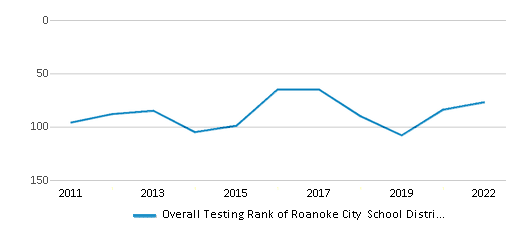
Math Test Scores (% Proficient)
23%
29%
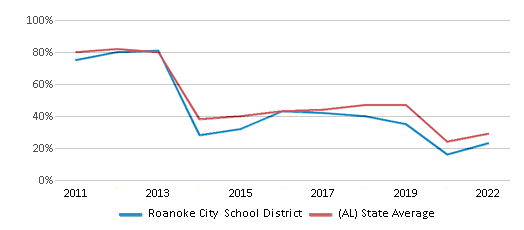
Reading/Language Arts Test Scores (% Proficient)
43%
47%
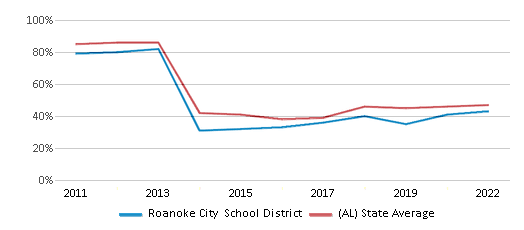
Science Test Scores (% Proficient)
32%
38%
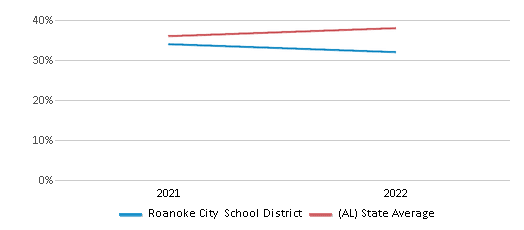
Graduation Rate
90-94%
88%

Students by Ethnicity:
Diversity Score
0.55
0.63
# American Indian Students
2 Students
4,587 Students
% American Indian Students
n/a
1%
# Asian Students
5 Students
7,150 Students
% Asian Students
n/a
2%
# Hispanic Students
22 Students
57,112 Students
% Hispanic Students
2%
11%
# Black Students
553 Students
161,465 Students
% Black Students
39%
31%
# White Students
791 Students
263,748 Students
% White Students
55%
51%
# Hawaiian Students
n/a
582 Students
% Hawaiian Students
n/a
n/a
# Two or more races Students
54 Students
21,276 Students
% of Two or more races Students
4%
4%
Students by Grade:
# Students in PK Grade:
90
20,227
# Students in K Grade:
104
54,285
# Students in 1st Grade:
103
58,528
# Students in 2nd Grade:
113
57,991
# Students in 3rd Grade:
96
55,161
# Students in 4th Grade:
103
54,229
# Students in 5th Grade:
99
54,176
# Students in 6th Grade:
106
54,851
# Students in 7th Grade:
92
40,400
# Students in 8th Grade:
97
39,777
# Students in 9th Grade:
106
7,285
# Students in 10th Grade:
98
6,720
# Students in 11th Grade:
107
6,390
# Students in 12th Grade:
113
5,900
# Ungraded Students:
-
-
District Revenue and Spending
The revenue/student of $12,383 in this school district is less than the state median of $13,006. The school district revenue/student has grown by 32% over four school years.
The school district's spending/student of $11,685 is less than the state median of $12,220. The school district spending/student has grown by 26% over four school years.
Total Revenue
$18 MM
$9,671 MM
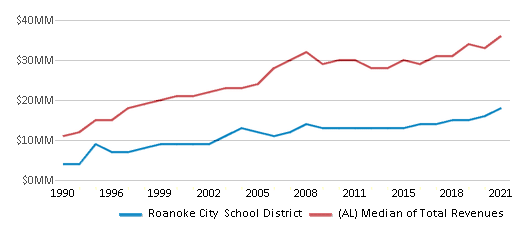
Spending
$17 MM
$9,086 MM

Revenue / Student (19-20)
$12,383
$13,006
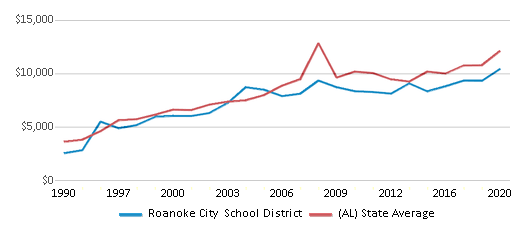
Spending / Student (19-20)
$11,685
$12,220

Best Roanoke City School District Public Elementary Schools (2025)
School
(Math and Reading Proficiency)
(Math and Reading Proficiency)
Location
Grades
Students
Rank: #11.
Knight Enloe Elementary School
(Math: 40-44% | Reading: 50-54%)
Rank:
Rank:
8/
Top 30%10
430 Park Ave
Roanoke, AL 36274
(334) 539-5261
Roanoke, AL 36274
(334) 539-5261
Grades: PK-3
| 506 students
Rank: #22.
Handley Middle School
(Math: 23% | Reading: 46%)
Rank:
Rank:
6/
Top 50%10
251 Gilham Rd
Roanoke, AL 36274
(334) 539-5265
Roanoke, AL 36274
(334) 539-5265
Grades: 4-8
| 497 students
Recent Articles

Year-Round Or Traditional Schedule?
Which is more appropriate for your child? A year-round attendance schedule or traditional schedule? We look at the pros and cons.

Why You Should Encourage Your Child to Join a Sports Team
Participating in team sports has a great many benefits for children, there is no doubt. In this article you will learn what those benefits are.

White Students are Now the Minority in U.S. Public Schools
Increasing birth rates among immigrant families from Asia and Central and South America, combined with lower birth rates among white families, means that for the first time in history, public school students in the United States are majority-minority. This shift in demographics poses difficulties for schools as they work to accommodate children of varying language abilities and socio-economic backgrounds.





